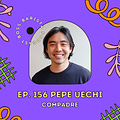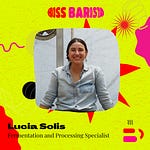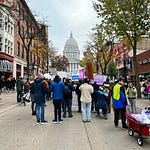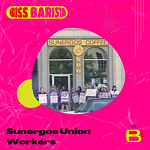Boss Barista is a weekly newsletter and podcast series about workplace equity and employee empowerment in coffee and beyond. If you’re not already subscribed, welcome! I’m glad you found your way here. Before you go, sign up, will ya? Here’s a cute little button to make it easy:
If the following piece resonates with you, consider donating to my Patreon. Pledges of any size help me produce these stories, and your support is gratefully received.
Today, I’m chatting with Jose Uechi, co-founder of Compadre, a coffee brand based in Peru. Jose—or Pepe, as he goes by—is an industrial designer by trade, and got into coffee because of his friend, Juan Pablo. Juan Pablo invented a solar roaster, a machine that could roast coffee without electricity. Initially, Compadre’s founders worked to get these roasters into the hands of farmers. They learned that farmers were only paid a few dollars per kilo of coffee, while roasters could fetch double, triple, or even quadruple that amount. Their solar-powered roasters were meant to shift some of that value down the supply chain by empowering farmers to roast and sell their own coffees.
A few years later, and Compadre is still working on raising wages for farmers—albeit in a slightly different way. In this episode, we talk about the shifts and pivots that Pepe and his team have made as they got deeper into the economics of coffee-buying and -selling. The broad goal of Compadre is still the same—to shift value down to farmers—but it does so now by removing barriers that farmers face (like unpredictable weather conditions) and building a brand that connects farmers to consumers.
I was introduced to Pepe and Compadre through Ana Sofía Narváez, who did a takeover episode of the podcast this past June, and it’s clear why she connected us: Compadre is a rare company that has been honest about how much its brand has shifted, and Pepe speaks to a lot of their early ideas about coffee and the needs of farmers. Rarely do people admit they’re wrong or that they’ve misunderstood something, but Pepe’s goal has always remained the same—to serve farmers first—and that’s involved a lot of honest reflection and a willingness to learn, change, and do better. Here’s Pepe:
Ashley: Pepe, I was hoping you could start by introducing yourself.
Pepe: Okay. I'm Pepe. I’m from Peru. I've been working in coffee since 2015, 2014. We started more with the technological part related to coffee, more related to the roasting.
Ashley: Can you tell me a little bit about coffee in Peru? I know that's a very big question, but when someone asks you, “What is coffee like there?” what do you say to them?
Pepe: I would say it's complex. It's diverse. Those would be the main things I would say.
You can find great coffees, people working really, really well. In the consuming part—here in the cities and also in the producing areas—consumption is growing and you can find people working really well, but you can also find the other side, right? People not doing a very good job, people that have a lot of work to do.
Ashley: Are you drinking coffee right now?
Pepe: Actually I am. I'm drinking a coffee coming from the central jungle that a friend from a cooperative gave me. It's a natural Bourbon; it's very sweet. It's very sweet, very fruity. I really like this coffee. You can find many profiles, different profiles here, whether if it's coming from the central jungle, the north or the south—we have those three main producing areas.
Ashley: People always want to classify a country as one way or another. Like, “Coffee from this country tastes like this, and coffee from this country tastes like that.” Even myself, I found myself wanting to ask you that question: What does coffee from Peru taste like? And I was like, “No, there are microclimates, there's diversity,” like you were saying.
I was wondering if you could tell me a little bit about Compadre, which is the company that you co-founded. How would you describe what Compadre does?
Pepe: Compadre is a brand of roasted coffee. We work with specialty coffee and we started actually, as I was saying, as a tech company who started developing technology to process coffee, to roast coffee, and to roast it in a sustainable way using solar energy. And that's how we started.
That was in 2015 when we started operations. Our model at the beginning was to build these machines and to try to sell these machines to farmers so they can process their own green coffee, their own parchment coffee, and they can add some value and they can sell roasted coffee—because, at the beginning we knew nothing about coffee. We started with this technological part.
Ashley: I want to go backwards on that because you mentioned that you didn't know anything about coffee when you first started.
So let's go back to when you first started Compadre: What drove you to start this company? Who were you folks before this started?
Pepe: So I have a friend—he's a mechanical engineer. He did a project, a research project in university for his undergraduate thesis. He built, together with other engineers and designers, a machine that could roast coffee on it with some mirrors and sunlight. So that was his project.
Some years later I was doing other kinds of projects with this friend—his name is Juan Pablo—and we were traveling through the jungle, we were doing projects with native communities, with schools. We loved working in the jungle, the Peruvian jungle has a special vibe for me. And we kind of fell in love with that.
We decided we wanted to work with [those communities], and we encouraged this friend to make something with the solar roaster and to have impact within these communities—a lot of these communities were coffee or cacao communities.
That's how we encourage him to present this project for a contest here. For this contest, he needed some partners. He told me and another friend, Fiorella, who is an anthropologist—[Juan Pablo] is a mechanical engineer and I'm an industrial designer. He told us, “Okay. We need a team. I need a team to present my project for these contests. Can you be part of the team?”
By that time, we had another friend who had a PhD in solar-concentrated energy. So we had a lot of chances to win with our project and we presented it and we won. We got some funding to start the project, to start developing the first and to start the pilot with one of the farmers we found at the beginning. That's how we started.
Ashley: That's so cool. I love that. This was just a project that Juan Pablo had designed years ago, it seems, and you found a new application for it. Was it obvious? At what point did it become clear that this could be a project—the solar roaster—that could impact farmers?
Pepe: Since the beginning, we tried to look to find what would be the impact of this. As we knew nothing about coffee, we only saw, “Okay, so how much [money] are farmers receiving here for their parchment coffee?”
If you go to origin, if you had asked a farmer at that moment what the price of coffee was, it was less than $2 per kilogram of coffee. We found that you can find roasted coffee for around $10, $8. So we said, “Okay. So if the farmer can roast the coffee, he can keep that $8 in his pocket, right?” That's the impact—that was our naive value proposition at the beginning.
But then we start working. We soon realized how the value chain works and what was the main problem, right? That it was the distance, the huge distance between the farmers and the final consumers. That's when we said, “Okay, we have to build a brand so we can commercialize this coffee with this story and we can ensure good prices for the farmer.”
Ashley: It's interesting that you were able to look at the value chain and see that immediate gap, because I don't think that's necessarily—it's obvious, but not, you know what I mean? That like, “Oh, if the farmer is selling his coffee for $2 a pound and the roaster is selling it for $10 per pound, let's transfer that value over to the farmer by giving them the power to roast green coffee.”
Which is really interesting, especially because you guys didn't have a background in coffee at all. So being able to identify that seems really powerful, but like you said, it was—I'm not going to call it naive, but you called it naive. But at what point did you realize that this wasn't going to be enough? You mentioned that you started to learn more about the value chain, what were you learning that told you, “Oh, this isn't going to be enough to change this.”
Pepe: It was when we started.
When we [gave a farmer] the first machine and we had a meeting with different farmers, different comparatives, different actors related to coffee, we showed it and they started asking questions. Everyone said, “Okay, so cool. That's so creative. So innovative,” but nobody really wanted it. We started asking, “Okay, why?”
We started asking questions, we sort of realized, “How are they going to [use this when they’re] isolated?” We were in Cusco, it’s in the south of Peru, and we said, “Okay, we're really far from the final consumer. How are they going to get there?”
We said, “We live in Lima. That’s the main market, so we'll have to commercialize this coffee there. They will have to send the coffee, they will have to produce a coffee and they will have to send it to us in Lima and we will have to sell it.” That was the first change in our model.
Ashley: Now that I'm thinking about it, I don't know if it was this simple, but it sounds like the initial idea you had was, “We have this solar roaster, farmers can have access to it because the infrastructure to operate the solar roaster is minimal, and we're going to be able to transfer value over to the farmers by giving them these roasters.” But there was no infrastructure on how that coffee was actually going to physically get to consumers. Is that right?
Pepe: I mean, it's the infrastructure, but it's also the knowledge, right? You need to operate a company to sell coffee to find a consumer. It's related to marketing related to finance related to a lot of things … relationships with other brands or distributors…
So it was a lot of work that the farmer—I mean, the farmer already has a lot of work on the farm, so it was a little bit too much.
Our next model was like, “Okay, we'll sell the coffee for the farmers in our impact model, we pay good prices—between 20 to 70% more than the market price was paying, depending on the quality we will find in the community. And then we’ll install a solar facility where people from the community, the farmers that sold the coffee to us, they could go there and they would work in sorting the coffee, the classification, and the roasting—and they would get paid for that.” That was our second model.
Ashley: Interesting. So there was still opportunity for farmers to roast their coffee, but there was an added level of infrastructure where Compadre would help sell the coffee and market the coffee. Is that right?
Pepe: Yes. And we were focusing on that.
Then we pivoted. When we had that model, we started growing the commercial part and we saw that the capacity of the technology was not enough.
So we said, “Okay, what do we do? Shall we try to roast coffee with a regular gas roaster? Or do we just stay with our solar-roasted coffee?” We thought if we want to make an impact for the farmers, if we want to buy coffee at good prices from more farmers for the community, we have to sell more coffee. That's when we started doing this hybrid production with solar and gas production.
Ashley: Did you have to rethink the way that you thought about sustainability at that point? Because I can imagine, going back to that presentation that Juan Pablo is grabbing you and grabbing all your partners—part of what made that really exciting is that you have the solar-powered roaster, that it doesn't need electricity, but then as you start to work with farmers and realize, “Oh, the things we need are way bigger, we have to think about sustainability differently.” Was that a conversation that you folks were having?
Pepe: Yeah. We were having a lot of these conversations.
It was mainly when it got to the point where we said, “Okay, are we going to roast coffee with the sun? Or we are going to roast coffee with the regular gas roaster?”
I said, “Let's sit together and let's define what are our main values or our main goals. Are we Compadre because we roast coffee with the sun, or are we Compadre because we want to make a change and we want to make a positive impact for the farmer?
We said, “The farmer is first.” That's the first thing. The first priority. If we can do things with solar energy, that would be amazing. But if we cannot do it, we still have to make an impact. We still have to keep working towards a future where we can be more sustainable, in the energy part or in the production part. That was second. [Across both fields] should be quality—that should be always there too. That's how we define our operations. And that's how we started planning ahead.
Ashley: It seems like in six years of operating a business that has drastically changed over time, you have learned so much about how value is created in the coffee industry.
Pepe: Yes. It's been a wild journey. We have learned a lot. Something good we’ve done, I would say since the beginning, was that we tried to spend a lot of time—most of the time—in the farms, right next to the farmer, and tried to understand how things were working over there.
From the city, you're going to see a lot of initiatives, a lot of certifications, a lot of programs, but what is really happening in the farm where you're supposed to see the impact—and then you go there and there are not many examples that are really working or working the way they should. It was good for us to travel a lot and try to understand how [these programs] were working and how we want to be part of that change.
I mean, it's so complicated. That's why we've been changing a lot because we were testing many things, but we’re still thinking, “What's the best way?” We are still trying different things right now with other projects, different projects.
Ashley: Are there any lessons or experiences that you had on coffee farms that you particularly remember or were exceptionally mind-changing for you?
Pepe: I'm sure I have many. You can pick the topic and I'll tell you a story if you want.
Just to give an example: We wanted farmers to sell their own coffee, the roasted coffee at some point, but when we started asking farmers how they used to move their [green] coffee from their farm to sell it—they would sell it in the closest city—some of them would take their coffee bags, like 60 kilograms of coffee in their shoulders. They would walk between five to eight hours just to sell one bag of coffee.
At least 10 years ago, most farmers would do that. You can still find some farms that are very high up and you cannot find roads and they have to just carry the coffee bags on their shoulders. They have to do all that work just to get to the closest city, to sell [their coffee] as parchment coffee, or to drink coffee. How would they even try to sell roasted coffee? It was crazy.
Ashley: One of the things that your website mentions is that you focus on two principles: on technology and Indigenous communities. I was wondering why Indigenous communities, why was that a specific goal that you wanted to focus on?
Pepe: We have a special—I don't know how to say, like feeling with Indigenous communities. We started our trips to the jungle working with Indigenous communities—Asháninka was the name of these Indigenous people.
They’re not the only kind of community we work with. Right now, we’re working with different farmers that are working on organic production, that have world-quality coffee, above 82 points a cup, and that are small coffee farmers.
We try to focus more on the smaller or medium-sized coffee farmers. If it's from an Indigenous community, even better, because we're trying to encourage them to keep their jobs in their communities, where they live. Because they have such a strong culture in their own communities.
We have spent so much time there and we find this special way of living in harmony with nature, in harmony with them working together, that we feel it's something that should be kept alive. We've also seen that a lot of these young people from these communities have to go to the nearest city to find another job and have more income. So it's possible to encourage them to stay, because they want to stay, but they just don't have the opportunity to. So if we can encourage that, that would be awesome.
Ashley: It sounds like you're saying that in the remote communities that you go to, there is a very strong Indigenous culture and that's being threatened by people leaving because they have to get job opportunities. So the work that you're trying to do is to preserve people's ability to stay within their communities and to essentially let their culture thrive in those communities.
Pepe: Exactly. Yeah. That a huge goal. Of course, we cannot do it by ourselves, but if we can help a little bit with that, that would be awesome.
Ashley: Is there a specific reason why you want to focus on Indigenous communities in particular? I know that you've mentioned that that's not the only people that you work with, but did you realize that Indigenous communities in particular were being threatened or were losing some of their access to their own culture because they couldn't sustain on what was being produced in their own communities?
Pepe: Indigenous communities have kind of special values or rules on how to live or how to protect their land or how to protect their own people, their own forest, that I think it's something we have to support. Because it's a good way of living. Of course, it's not a rule. I'm being general, but it's sometimes a pattern you can see in native communities. For us, it has a lot of value.
Ashley: That totally makes sense.
Let's talk a little bit about what Compadre’s current iteration is looking like, because as you mentioned, you've had a lot of iterations, which I think is really unique for a company—not necessarily to have a lot of iterations, I think that that happens to a lot of companies, but I think it's unique that you're very upfront about it, because that says to me that you're willing to listen to farmers. As you mentioned, traveling to different farmers in different communities, it seems like a lot of the solutions that you've generated have come from those conversations.
Pepe: Yes. There's this—and actually, as we are part of many parts of the value chain, we can also have a bigger picture on how things are working and what things should be done.
Right now what we are doing—I mean, after the pandemic or during the pandemic, it was so difficult for us to keep operations in the jungle with the farmers because most of the coordinations we did by being there. The communication, the technological part, they are not used to coordinating if they don't see you, so it was kind of complicated to keep that model.
So we had to find a partner in one of the cities in the jungle, a specialist. He's also a Q grader, he's a roaster, he's a specialist in coffee. So we partnered with him and he would be the one who visited the farms, the one who would talk to the farmers, he was the one that started projects. And we focused more on the quality part. He would go to the farms and make suggestions.
We started doing a project with a couple of farmers, trying different kinds of fermentation [during processing]. So he had all the tools necessary to make sure [he could measure] temperature, Brix, and then he would cup those coffees and would try to choose the right fermentation process for each coffee.
We would support these farmers with infrastructure, meaning for the drying process, solar dryers. We sold a couple of solar dryers—one of them a conventional solar dryer and another, it was with a new development we did to improve the drying process. We saw that one of the biggest problems [for farmers] was the drying process.
Ashley: Can you talk a little bit about that? Just for people who maybe don't even know what the drying process is for coffee—how are you seeing it? What does that look like for farmers?
Pepe: After the farmers pick the coffee, depulp or ferment the coffee and wash it, they have to put it into a dryer or they have to dry it. They have to go from, I dunno, 55%, 45% humidity, to around 10 to 12% humidity, but they have to do it in a proper way, in a consistent way, so they can reach water activity under 0.7—0.6 would be better. You need consistency for that.
If you are doing, for example, naturals or the pulp natural process, it's super important that the first days you have consistency in the drying process. And of course, the better coffees, the best coffees, you find them above 1,500 meters above sea level. And in some areas, above that altitude it’s very humid and the temperatures are quite low during the night. So you lose a lot of consistency in the drying process because you lose humidity.
And then, if it rains one day, the humidity goes up. So it's so chaotic. Sometimes farmers with great coffees, they have to just take their own coffee and put it in a regular mechanical roaster and they lose quality—or as it happened to one of our farmers, he wanted to do naturals last year, he did great naturals. And this year he's pulled all his naturals because when he harvested, the weather was really bad. He had four very humid days. And the naturals, they got spoiled.
Ashley: I think this is a really key thing. I just want to stop for a minute just because I want to make sure that people understand how important it is that the weather affects how coffee taste.
I think that that's taken for granted. I think people assume—most of the people who listen to this podcast are coffee people. I think a lot of people know this intuitively or at least have some experience with this, but lately more people who don't know coffee very well have been listening. So I just want to make sure that people understand that like, if it rains too early, your coffee can be messed up. Drying, especially naturally processed coffee where the cherry stays around the coffee bean, can be really volatile. Because that could take anywhere from one to three weeks to dry. So you really need to have consistent temperatures to make sure that those coffees dry, not only correctly, but consistently, as you were saying, that one cherry isn't at 40% moisture and then the other one's 10% moisture.
Sorry, I didn't mean to cut you off there, but I wanted to make sure that that was super clear.
Pepe: Yes, yes. Seems easy, the drying process.
Ashley: It seems easy!
Pepe: At the beginning, it seems easy, right? When you study the whole value chain, the whole process, you say, “Okay, the drying process looks like the easiest process.” But it's not because you have different conditions, weather conditions that are key in order to keep a consistent drying process. And if you lack good weather at that point, you can spoil all the great work you did before—in the harvesting, in the fermentation, for example.
Ashley: So it seems like if we zoom outward a little bit on Compadre’s mission, the mission for you folks is to create positive impact for farmers and to really think about sustainability, not necessarily as environmental impact, even though that's important, but to think about sustainability as social impact, is that right?
Pepe: Yes. As a social entrepreneurship, we've seen that sustainability for us should be a balance, right? Because at some point we need to work more in the social part. At some point when we have the resources, we will work more on the technological parts so we can [pay more attention to] sustainability on the production side and on the energy side. And at some point we will have to say, “Okay, we have to reduce costs and we have to focus more on selling coffee. Otherwise we will die as a company and we will stop all the impact we've been building so far.”
It's always been, through all these years, it's been a balance. It's been a decision-making process on which part of the sustainability [equation] we have to focus on now.
Ashley: Right. Which must be really hard because there's so many things, especially as you get more and more involved in the coffee roasting side, or the coffee production side of things—more things come up.
Because I'm sure before you started Compadre, you weren't thinking about the drying process—that wasn't part of your business model—but now that you're more involved in the value chain, you're like, “Oh, this is actually a really key, pivotal part.”
What I think is interesting about focusing on the drying of coffee is that it really focuses specifically on the farmers. A lot of coffee—I'm not sure if this is always true in Peru, because I know in different countries it can kind of depend—but is most of the drying done on the farm?
Pepe: Yes.
Ashley: So a lot of that impact that you're focusing on is directly focusing on farmers, giving them tools specifically.
Pepe: Exactly. Exactly, yes. I think one of the good things we've always had is that our purpose is clear, right? So it doesn't matter how much our model pivots or changes at the end. We try to do something better for the farmer, for the quality or for the actors in the value chain that are working properly.
So I don't know. That's why we changed the way we're working and now we are focusing on the drying process, but it's still trying to impact the farmer. A lot of factors would be—[there would be lots of benefits from a good drying process], but the farmer would be one of the main beneficiaries of this.
Ashley: I know that this is a big question, so feel free to take it in whatever direction you want, but what do you think is your biggest success so far?
Pepe: To be alive? Yeah. I remember when we started in the incubation program, when we started Compadre, because we started after we won this contest and we enter this incubation program. There were five other projects. And the director said, “Okay, next year, or maybe in two years, only one of you will be alive.”
Ashley: Oh, wow.
Pepe: The other four will die. And here we are.
Ashley: I don't want to out the other companies, but did the other ones not make it? Do you know?
Pepe: Many reasons, many different reasons.
Ashley: We don't need to know why, but are you the one company that stayed alive out of that whole group?
Pepe: Yeah. That's what I'm trying to say. We are the one company still alive.
Ashley: That's an accomplishment. That's huge.
Pepe: Yeah.
Ashley: What do you think has kept you folks alive?
Pepe: I would say our commitment. Our team is super important. Whenever you have these kind of projects—because at some point you are so disappointed by the results and to have a partner that levels you up, brings you up. Who says, “Okay, we're still doing these things, we've done all this much and we can still do it.” And then maybe, I don't know, some months later he's the partner that’s down, and you have to be the one trying to encourage the team to keep up the good work we’re doing.
Ashley: Yeah. That can be really hard.
Pepe: Another thing is that we are not afraid to adapt to different things, to different models, to different ways of work.
Ashley: It seems like you folks are always learning and you're always taking in knowledge and improving on what you've learned.
Pepe: Yeah. Actually at some point, when we said, “Okay, we are not a tech company anymore. We are more like a coffee company. Some of us should be experts in coffee.” That's why I did a Masters in Coffee Economics and Science with Illy—initially with Ana Sofia, that's where I met her. So we try to adapt, and now we’re a specialty coffee brand.
Ashley: So you have a goal to improve the lives of coffee farmers. I know that this is a very big goal, but what would be an ideal situation for you? When would you feel like your mission has been accomplished? What would the farmers have, or what structures would be in place, where you'd be like, “Okay, this is what we were hoping for”? Again, I know that that's a big question.
Pepe: It is. I would love to have a strong value chain, working with the same farmers I've been working with—at least 60 or 70% of the farmers we're working with would be the same farmers we've been working with since, I don't know, two or three years ago, because that's a good indicator that you are doing a good job with them.
That they are every year increasing their production or their income because they are improving their quality. And that we are also sustainable in the commercial part, that we are very stable. That we have strong relationships with our customers and that we are positioned to be the sustainable coffee brand here in Peru. And that if someone else wants to sell sustainable coffee, they would have to look at us and say, “Okay, let's try to do something similar. Let's try to have the impact they're having in order to say we are sustainable too.”
That would be the vision we have. And of course we want to close the whole experience and be closer to the final consumer. That’s the person who has to understand all of this. We want to close it with a coffee shop, with a cafeteria. That hopefully will happen soon.
Ashley: I think it's interesting when you have a company that focuses on social entrepreneurship, because logically at some point your work may never be done, but the goal is almost for your work to be done.
The goal is that you don't need Compadre anymore, or you do, but you don't need it to be as active in improving farmers' lives because that's already been done. The value chain is “fixed.” Even though, like we were saying, that's a huge goal and maybe won't happen overnight or won't happen in six months, but do you think about that? Do you think about the world that you'd create that doesn't need you anymore?
Pepe: I mean, this question it so interesting because a lot of times I've questioned myself and it's like, “Okay, how big can we be? How many farmers can we impact at some point, right, by being just one brand?” Because we are, as a social entrepreneurship, we are competing against huge companies that have aids in the market. Right. And they have super strong value chains.
So how big can we be? How many farmers can we impact? And we see the projections and it's like, “Okay, we can, I don't know, impact 50 farmers next year, maybe 70 in two years,” but it's still in a universe of 200,000 coffee farmers in Peru. It's very little, right?
So if I'm looking for impact, should I be doing this? Or should I be working in a huge NGO or in another big company trying to push this next sustainability … but I think something very important is the story you can create in your own company, in your own value chain, and that you can inspire other people, other companies, other people working in huge companies to start doing things similar to what you are doing.
If we can show that it's possible to be sustainable, to be a business and to be sustainable and responsible with the environment, with the farmer, and that we can push technology and creativity—if we demonstrate that that's possible, I would say that's a huge goal that we can reach.
Ashley: It's really a story of optimism, in a way.
Pepe: Yes, exactly. And it's something that our society needs a lot in these times. Right?
Ashley: Well, Pepe, thank you so much for taking time to chat with me. I really appreciate it.
Pepe: No, thanks for the invitation, Ashley, and congratulations for the great work you are doing.
Ashley: Congratulations on the great work you're doing.
Pepe: Thank you very much.
This Boss Barista episode is brought to you by Urnex.
One of Urnex’s latest advances is a range of environmentally friendly cleaners called Biocaf. Biocaf products are made entirely from plant- and mineral-based ingredients and are fully biodegradable. They're available for both commercial nd household coffee equipment.
Urnex is also partnering with coffee pros—like me!—to highlight some of the best sustainability efforts in the industry with the Biocaf Sustainability Series. You can read my most recent piece on Onyx Coffee Labs’ switch to oat milk in their latest café, and learn more about Biocaf here. And be sure to read the dozens of pieces focusing on sustainability in coffee and beyond.
Hold up! You made it to the bottom of this article! Thank you so much for reading! If you could do any or all of the following things, that’d be incredibly helpful!
Click the ‘heart’ at the bottom to say you liked this article!
Consider checking out my Patreon!
Share this with a friend, on your social media, anywhere! Here’s a button for you to do so!















Pepe Uechi Isn't Afraid To Pivot